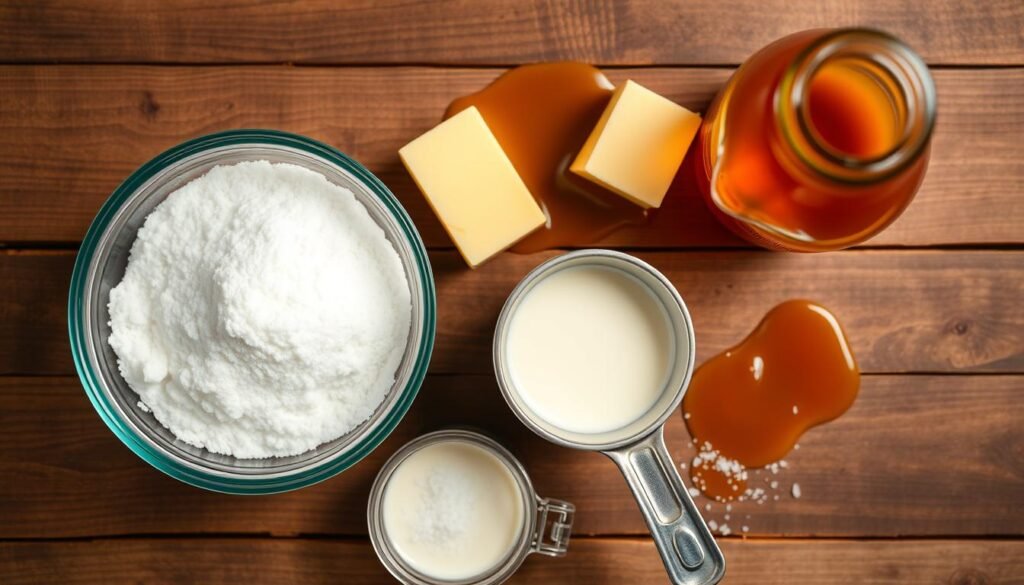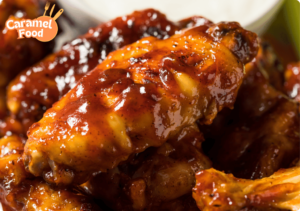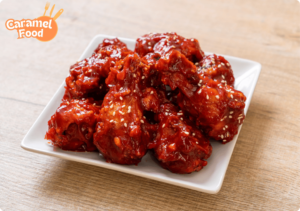Calling all dessert lovers! Get ready to make a delicious homemade caramel sauce in just 5 minutes. You’ll need simple ingredients from your pantry. This sauce is great on ice cream, cakes, pies, and even as a fruit dip.
It’s an easy recipe that will wow your family and friends. So, get ready to take your desserts to the next level.
Key Takeaways
- Homemade caramel sauce can be made in just 5 minutes
- Use common pantry ingredients to create a delicious caramel topping
- Caramel sauce is versatile and can be used on a variety of desserts and beverages
- Enjoy a fresh, high-quality caramel flavor compared to store-bought options
- Impress your loved ones with this easy, homemade caramel recipe
Why Make Your Own Caramel Sauce at Home
Homemade caramel sauce is a game-changer for desserts and savory dishes. Making your own caramel at home has many benefits. It’s worth the time and effort.
Cost-Effective Benefits
One big advantage of homemade caramel sauce is saving money. You only need sugar, butter, and cream, which are cheap. This way, you get a budget-friendly dessert without losing quality.
Superior Fresh Taste
Homemade caramel sauce tastes better than store-bought. Caramelizing sugar at home creates a rich flavor. You can also add vanilla or spices for custom caramel flavors.
Control Over Ingredients
When you make caramel sauce at home, you control what goes in it. This means no preservatives or artificial flavors. You can also adjust the sweetness and consistency to your liking.
Choosing to make your own caramel sauce is about wanting better taste, saving money, and being able to customize. With just a few ingredients, you can make your dishes stand out and impress everyone.
Essential Ingredients for Perfect Caramel Sauce
Making a tasty caramel sauce at home is easy with just a few ingredients. Sugar is the base, and it comes in different types. Each type gives a unique taste and texture.
Granulated white sugar is a classic pick. But brown sugar and maple syrup can make your caramel more complex.
Butter is also key, adding a creamy feel. For a dairy-free option, use coconut oil or plant-based butter. Heavy cream or full-fat milk makes the sauce smooth. If you can’t have dairy, try almond or oat milk.
Adding vanilla extract, sea salt, or a bit of espresso powder can enhance the flavor. These ingredients make your caramel sauce stand out. You can drizzle it over ice cream, layer it in desserts, or enjoy it on its own.
| Ingredient | Purpose | Substitutions |
|---|---|---|
| Sugar | Provides sweetness and caramelization | Brown sugar, maple syrup |
| Butter | Adds richness and creaminess | Coconut oil, plant-based butter |
| Cream or Milk | Enhances texture and smoothness | Almond milk, oat milk |
| Flavorings | Elevates the overall taste | Vanilla extract, sea salt, espresso powder |
“A beautifully arranged flat lay of caramel sauce ingredients, featuring a bowl of granulated sugar, a small pot of unsalted butter, a jar of heavy cream, and a sprinkle of sea salt, all on a rustic wooden surface, with warm lighting to enhance the inviting colors.”
“Caramel sauce is the ultimate indulgence, a liquid gold that elevates any dessert or snack to new heights of deliciousness.”
Kitchen Tools and Equipment Needed
Creating delicious caramel sauce at home requires the right caramel making tools and kitchen safety equipment. You’ll need essential utensils and some optional tools to make your caramel sauce. Let’s look at what you need to make your homemade caramel sauce a success.
Must-Have Utensils
- Heavy-bottomed saucepan: This helps distribute heat evenly and prevents burning.
- Wooden spoon or silicone spatula: These won’t scratch your pans and are perfect for stirring the caramel.
- Candy or digital thermometer: Crucial for monitoring the temperature of the caramel as it cooks.
- Whisk: Useful for blending the caramel ingredients and ensuring a smooth, lump-free texture.
Safety Equipment
Working with hot sugar needs extra kitchen safety equipment to avoid burns. Here are the essential items:
- Heat-resistant gloves: Safeguard your hands when handling the hot caramel.
- Apron: Protect your clothing from splatters and spills.
- Baking sheet or tray: Have a surface ready to pour the finished caramel onto, should you need to stop the cooking process quickly.
Optional Tools for Easier Preparation
While not strictly necessary, these caramel sauce utensils can make the process easier:
- Lemon juice or vinegar dispenser: Helpful for precisely measuring and adding acid to the caramel.
- Squeeze bottle: Allows for easy drizzling and decorating of the finished caramel sauce.
- Pastry brush: Useful for brushing down the sides of the pan to prevent sugar crystallization.

A collection of kitchen tools arranged on a wooden countertop, featuring a heavy-duty saucepan with a shiny finish, a wooden spoon, a digital kitchen thermometer, a measuring cup filled with sugar, and a bowl of butter, complemented by a small flickering flame from a gas stove in the background, all captured in warm, inviting lighting.
With the right tools and equipment, you’ll be well on your way to creating the perfect homemade caramel sauce. Remember to prioritize safety as you work, and let’s get cooking!
Best Sugar Types for Caramel Sauce Recipe
Choosing the right sugar is key to making perfect caramel sauce. Granulated sugar for caramel is the most common choice. But, other sugars can add unique flavors and textures to your homemade caramel.
Brown sugar caramel is a popular choice. It adds a deeper, more complex sweetness. The molasses in brown sugar gives a rich, toffee-like flavor. Muscovado or turbinado sugar can also give similar results.
For a healthier option, try sugar substitutes like maple syrup, honey, or dates. These natural sweeteners reduce sugar content and add their own flavors to the sauce.
“The key to choosing the right sugar for your caramel sauce is to consider the flavor profile you’re aiming for and how it will complement the other ingredients in your recipe.”
The best sugar for your caramel sauce depends on your taste and desired outcome. Trying different sugars can lead to exciting new flavors of this classic dessert topping.
Safety Tips and Precautions When Making Caramel
Making homemade caramel sauce is fun, but safety comes first. Caramel is made by heating sugar to high temperatures. This can be risky if not done right. Follow these caramel safety precautions for a safe and enjoyable time in your kitchen safety.
Temperature Management
Getting the right temperature is key for perfect caramel. Watch the sugar closely and use a candy thermometer. Don’t let it go over 350°F (177°C) to avoid bitterness and danger.
Proper Handling Techniques
- Wear protective gloves and use long-handled utensils to minimize the risk of burns.
- Keep a bowl of ice water nearby in case you need to quickly cool your hands in the event of a spill.
- Move slowly and carefully when pouring or transferring the hot caramel to avoid splashing.
Emergency Measures
Even with care, accidents can happen. If you get burned, cool the area in water for at least 10 minutes. Get medical help for serious burns or large areas of skin.
| Safety Tip | Importance |
|---|---|
| Monitor temperature closely | Prevents burning and bitterness |
| Use protective equipment | Reduces risk of burns and spills |
| Have emergency measures in place | Ensures proper first aid for burns |
By sticking to these safety tips, you can make caramel safety precautions at home safely. This way, you can enjoy making caramel without worrying about burn prevention and kitchen safety.
Step-by-Step Cooking Process
Making a rich, velvety caramel sauce at home is simpler than you might think. Follow these easy steps to create your own homemade caramel sauce with just a few ingredients and minimal effort.
- Start by gathering all your ingredients and equipment. You’ll need a heavy-bottomed saucepan, a wooden spoon, and a heat-resistant spatula.
- In the saucepan, combine the sugar and water. Gently heat the mixture over medium-low heat, stirring occasionally, until the sugar has fully dissolved.
- Once the sugar has dissolved, stop stirring and let the mixture come to a boil. Do not stir the caramel at this stage, as it can cause the sugar to crystallize.
- Keep a close eye on the caramel, allowing it to cook until it reaches a deep amber color. This should take about 5-8 minutes, but keep a watchful eye as the color can change quickly.
- When the caramel reaches the desired color, carefully and slowly pour in the heavy cream. The mixture will bubble and steam, so be cautious.
- Whisk the mixture continuously until the cream is fully incorporated, and the caramel sauce is smooth and silky.
- Remove the saucepan from the heat and stir in the butter and a pinch of salt, if desired, to enhance the flavor.
And there you have it! Your homemade caramel sauce is now ready to be enjoyed. Be sure to let it cool slightly before drizzling over your favorite desserts or indulging with a spoon.
| Caramel Cooking Stages | Temperature Range | Visual Cues |
|---|---|---|
| Melting | 212-320°F (100-160°C) | Granulated sugar begins to melt and turn clear |
| Caramelization | 320-338°F (160-170°C) | Sugar turns golden brown, developing a nutty aroma |
| Dark Caramel | 338-374°F (170-190°C) | Sugar turns a deep amber color, with a rich, almost bitter taste |
Remember, temperature control is key when making caramel sauce. Use a candy thermometer to monitor the temperature and avoid over-caramelizing your sauce.
Common Mistakes to Avoid
Making caramel sauce at home can be tricky, even for experts. Let’s look at some common caramel sauce troubleshooting problems. We’ll also talk about how to avoid them for a smooth caramel-making experience.
Temperature Control Issues
Temperature is key in caramel-making. Too high heat can burn the sugar, making it taste bitter. Too low heat slows down caramelization, making the sauce watery. To fix this, keep a close eye on the temperature and adjust the heat as needed.
Timing Problems
Timing is also crucial. Cooking sugar too long can make it crystalize or turn dark. Cooking it too short keeps it pale and flavorless. Practice helps, but following the recipe and watching the pot closely is key for the right caramel consistency.
Ingredient Mistakes
Using the wrong ingredients or adding them wrong can mess things up. Cold cream or milk can make caramel lumpy. The wrong sugar or missing ingredients like salt or vanilla can ruin the flavor. Always check the recipe and measure ingredients carefully for a smooth sauce.
By avoiding these common caramel sauce troubleshooting mistakes, you’ll make perfect caramel sauce every time.
Storage and Shelf Life Guidelines
Proper storage is crucial for keeping your homemade caramel sauce fresh. Once it cools, move it to an airtight container or jar. Then, refrigerate it for up to 2 weeks. This step is vital to storing caramel sauce and keeping it from spoiling.
To make the caramel shelf life even longer, freeze it for up to 3 months. When you’re ready to use it, thaw it in the fridge overnight. To reheat, use a microwave-safe bowl and heat in 30-second intervals, stirring between each, until it’s smooth again.
Whether you choose to refrigerate or freeze, always keep it tightly sealed. This prevents refrigerating caramel from drying out or getting a bad skin. With the right storage, your homemade caramel sauce can last for weeks or even months.
FAQ
What are the key ingredients for making homemade caramel sauce?
To make caramel sauce, you need granulated sugar, butter, heavy cream, and a pinch of salt. You can also add vanilla extract or other flavorings to make it your own.
What kitchen tools and equipment are needed to make caramel sauce?
You’ll need a heavy-bottomed saucepan, a heat-resistant spatula or whisk, and a candy thermometer. Don’t forget oven mitts or heat-resistant gloves for safety. Optional tools include a high-sided baking sheet and a silicone mat.
What are the best types of sugar to use for caramel sauce?
Granulated white sugar is the classic choice. But you can try brown sugar, muscovado, or coconut sugar for different flavors. Avoid honey or maple syrup as they can change the texture.
What safety precautions should be taken when making caramel sauce?
Caramel gets very hot, so be careful. Wear oven mitts or heat-resistant gloves and watch the pot closely. Have a baking sheet ready in case it boils over. If you get burned, cool the area with cool water right away.
How do I store homemade caramel sauce and how long does it last?
Homemade caramel sauce can last up to 2 weeks in the fridge. Store it in an airtight container in the fridge. To reheat, use the microwave or a saucepan with a bit of water until it’s smooth again.
What are some common mistakes to avoid when making caramel sauce?
Avoid not controlling the temperature, adding cold ingredients too fast, and not cooking the sugar enough. Watch for color and texture changes and adjust the heat as needed to avoid burning or crystallization.



